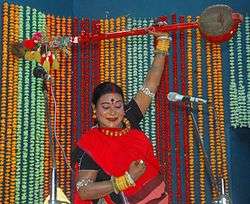Teejan Bai
| Teejan Bai | |
|---|---|
 | |
| Born |
24 April 1956 Ganiyari village, Chhattisgarh |
| Occupation | Pandavani Folk Singer |
| Spouse(s) | Tukka Ram |
| Awards |
Padma Bhushan 2003 Padma Shri 1988 Sangeet Natak Akademi Award 1995 |
Teejan Bai (born 24 April 1956) is an exponent of Pandavani, a traditional performing art form, from Chhattisgarh, in which she enacts tales from the Mahabharata, with musical accompaniments.
She has been awarded the Padma Shri in 1988, and Padma Bhushan in 2003 by Government of India, besides 1995 Sangeet Natak Akademi Award in 1995, given by Sangeet Natak Akademi, India's National Academy of Music, Dance & Drama.
Biography
Early life
Teejan Bai was born in Ganiyari village, 14 kilometres (8.7 mi) north of Bhilai, to Chunuk Lal Pardhi and his wife Sukhwati.[1] She belongs to the Pardhi Scheduled Tribe of Chhattisgarh state
The eldest among her five siblings she heard her maternal grandfather, Brijlal Pradhi, recite the Mahabharata written by Chattisgarhi writer, Sabal Sinh Chauhan in Chattisgarhi Hindi and instantly took a liking to it. She soon memorised much of it, and later trained informally under Umed Singh Deshmukh.
Career
At age 13, she gave her first public performance in a neighbouring village, Chandrakhuri (Durg) for Rs 10., singing in the Kapalik shaili (style) of 'Pandavani', a first time for a woman, as traditionally women used to sing in the Vedamati, the sitting style. Contrary to the tradition, Teejan Bai performed standing singing out loud in her typical guttral voice and unmistakable verve, entering what was till then, a male bastion.[2]
Within a short time, she became known in neighbouring villages and invitations poured to perform at special occasions and festivals.
Her big-break came, when Habib Tanvir, a theatre personality from Madhya Pradesh, noticed her talent, and she was called to perform for then Prime Minister, Indira Gandhi. In time she received national and international recognition, a Padma Shri in 1988,[3] Sangeet Natak Akademi Award in 1995, and Padma Bhushan in 2003.
Beginning in the 1980s, she travelled all over the world as a cultural ambassador, to countries as far as England, France, Switzerland, Germany, Turkey, Tunisia, Malta, Cyprus, Romania and Mauritius.[4]
Today she continues to enthrall audiences, the world over with her unique folk singing and her powerful voice; and pass on her singing to the younger generation.
Personal life
Though she was married at 12, she was expelled by the community, the 'Pardhi' tribe, for singing Pandavani, being a woman. She built herself a small hut and started living on her own, borrowing utensils and food from neighbours, yet never left her singing, which eventually paid off for her.[5] She never went to her first husband's home and later split(divorce). In the following years, she was married twice, though none of her marriages succeeded. Later she fell in love with Tukka Ram, a former harmonium player in her troupe, and they had three children.
Today she lives with her fourth husband, Tukka Ram, her five children, in Sector 1, Bhilai, where she is employed at the Bhilai Steel Plant. She travels the world for her performances. She is also a grandmother.
Performance style
Pandavani, literally means stories of Pandavas, the legendary brothers in Mahabharat, and involves enacting and singing with instrumental accompaniment an ektara or a tambura in one hand and sometimes a kartal in another. Interestingly, as the performance progresses, the tambura becomes her only prop during her performances, sometimes she uses it to personify a gada, mace of Arjun, or at times his bow or chariot, while others it becomes the hair of queen Draupadi, allowing her to play various character with effective ease and candour.[6] Her acclaimed performances are of, Draupadi cheerharan, Dushasana Vadh and Mahabharat Yudh, between Bhishma and Arjun.
Awards
- 1988 Padma Shri
- 1995 Sangeet Natak Akademi Award[7]
- 2003 Hon. D. Litt, Bilaspur University[8]
- 2003 Padma Bhushan[9]
See also
References
External links
- Facebook page
- Teejan Bai, a profile on her narration of the Mahabharata
- Portrait of Teejan Bai at Kamat.com